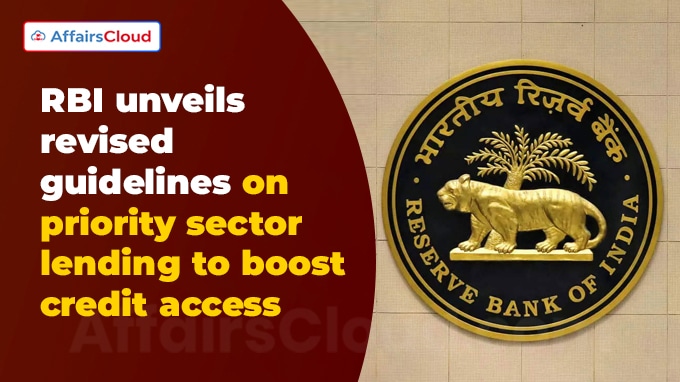 On March 24,2025 The Reserve Bank of India (RBI) revised guidelines on Priority Sector Lending (PSL) to boost credit access. These guidelines were issued under – ‘Master Directions – Reserve Bank of India (Priority Sector Lending – Targets and Classification) Directions, 2025’. These Directions shall come into effect on April 01, 2025.
On March 24,2025 The Reserve Bank of India (RBI) revised guidelines on Priority Sector Lending (PSL) to boost credit access. These guidelines were issued under – ‘Master Directions – Reserve Bank of India (Priority Sector Lending – Targets and Classification) Directions, 2025’. These Directions shall come into effect on April 01, 2025.
The Reserve Bank of India has, from time to time, issued a number of instructions/ guidelines to banks relating to PSL. The following are the major changes:
- Enhancement of several loan limits, including housing loans for enhanced PSL coverage,
- Broadening of the purposes based on which loans may be classified under ‘Renewable Energy’,
- Revision of overall PSL target for Urban Co-operative Bank (UCBs) to 60 per cent of Adjusted Net Bank Credit (ANBC) or Credit Equivalent of Off-Balance Sheet Exposures (CEOBSE), whichever is higher.
- Expansion of the list of eligible borrowers under the category of ‘Weaker Sections’, along with removal of the existing cap on loans by UCBs to individual women beneficiaries.
Purpose of PSL:
The purpose of the PSL framework is for ensuring adequate flow of credit from the banking system to the sectors of the economy which are crucial for their contribution to socio-economic development, with focus on specific segments whose credit needs remain underserved despite being credit worthy.
Applicable to:
The provisions of these Directions shall, unless otherwise provided, apply to every
i.Commercial Bank [including Regional Rural Bank (RRB),
ii.Small Finance Bank (SFB),
iii.Local Area Bank (LAB)] and
iv.Primary UCB other than Salary Earners’ Bank.
1.Priority sector lending targets for UCBs:
60 percent of ANBC or CEOBE, whichever is higher, from FY2024-25 onwards:
- UCBs are required to achieve an overall PSL target of 75 per cent of ANBC or CEOBSE, whichever is higher, by FY2025-26, with interim targets of 60 per cent (FY2023-24) and 65 per cent (FY2024-25).
| Categories | Targets as a percentage of ANBC or CEOBSE, whichever is higher |
|---|---|
| Total Priority Sector | 60% |
| Micro Enterprises | 7.5% |
| Advances to Weaker Sections | 12% |
2.Enhancement of several loan limits
A.Agriculture
The lending to agriculture sector will include Farm Credit (Agriculture and Allied Activities), lending for Agriculture Infrastructure and Ancillary Activities.
Farm Credit – Individual farmers:
i.Loans against pledge/hypothecation of agricultural produce (including warehouse receipts) for a period not exceeding 12 months subject to a limit up to Rs.90 lakh against Negotiable Warehouse Receipt (NWRs)/Electronic Negotiable Warehouse Receipt (eNWRs) and up to Rs.60 lakh against warehouse receipts other than NWRs/eNWRs.
Farm Credit – Corporate farmers:
Corporate farmers including Farmer Producer Organisations (FPOs)/(FPC) Companies of Individual Farmers, Partnership firms and Co-operatives of farmers engaged in Agriculture and Allied Activities
i.Loans for the following activities, subject to an aggregate limit of Rs.4 crore per borrowing entity, will be eligible:
- Crop loans to farmers which will include traditional/non-traditional plantations and horticulture and loans for allied activities.
- Medium and long-term loans for agriculture and allied activities.
- Loans for pre and post-harvest activities viz., spraying, harvesting, grading and transporting of their own farm produce
ii.Loans up to Rs4 crore against pledge/hypothecation of agricultural produce (including warehouse receipts) for a period not exceeding 12 months against NWRs/eNWRs and up to Rs2.5 crore against warehouse receipts other than NWRs/eNWRs.
iii.Loans up to Rs10 crore per borrowing entity to FPOs/FPCs undertaking farming with assured marketing of their produce at a pre-determined price.
Eligibility criteria for categorization as lending to Small and Marginal Farmers (SMFs):
i.Farmers with landholding of up to 1 hectare (Marginal Farmers)
ii.Farmers with a landholding of more than 1 hectare and up to 2 hectares (Small Farmers)
iii.Loans up to Rs.2.5 lakh to individuals solely engaged in allied activities without any accompanying land holding criteria.
Note: UCBs are not permitted to lend to co-operatives of farmers (others can).
B.Micro, Small and Medium Enterprises (MSMEs)
Other Finance to MSMEs:
Loans to registered NBFCs (other than Microfinance Institutions (MFIs)) for on-lending to micro and small enterprises up to Rs.20 lakh per borrower. (not applicable to RRBs, SFBs and UCBs)
C.Export Credit
| Domestic banks/WoS of Foreign banks/SFBs/UCBs | Foreign banks with 20 branches and above | Foreign banks with less than 20 branches |
|---|---|---|
| Incremental export credit over corresponding date of the preceding year, up to 2 per cent of ANBC or CEOBSE whichever is higher, subject to a sanctioned limit of up to Rs.50 crores per borrower. | Incremental export credit over corresponding date of the preceding year, up to 2 percent of ANBC or CEOBSE whichever is higher. | Export credit up to 32 per cent of ANBC or CEOBSE whichever is higher. |
*WoS – Wholly Owned Subsidiary
D.Education
Loans to individuals for educational purposes, including vocational courses, not exceeding Rs.25 lakhs will be considered as eligible for priority sector classification.
E.Housing
Loans to individuals for purchase/construction of a dwelling unit per family subject to the following limits:
| (Amount in Rs lakh) | ||
| Category | Loan Limit# | Maximum Cost of Dwelling Unit# |
|---|---|---|
| Centres with population of 50 lakh and above | 50 | 63 |
| Centres with population of 10 lakh and above but below 50 lakh | 45 | 57 |
| Centres with population below 10 lakh | 35 | 44 |
| #to be eligible, the loan to satisfy both the criteria | ||
Loans for repairs to damaged dwelling units shall be eligible for priority sector classification subject to the following limits:
| (Amount in Rs lakh) | ||
| Category | Loan Limit# | Maximum Cost of Dwelling Unit# |
|---|---|---|
| Centres with population of 50 lakh and above | 15 | 63 |
| Centres with population of 10 lakh and above but below 50 lakh | 12 | 57 |
| Centres with population below 10 lakh | 10 | 44 |
| #to be eligible, the loan to satisfy both the criteria | ||
F.Social Infrastructure
i.Loans up to a limit of Rs.8 crores per borrower for setting up schools, drinking water facilities and sanitation facilities including construction/refurbishment of household toilets and water improvements at household level, etc.
ii.Loans up to a limit of Rs.12 crores per borrower for building health care facilities in Tier II to Tier VI centres.
3.Renewable Energy
i.Bank loans up to a limit of Rs.35 crores to borrowers for renewable energy-based power generators and for renewable energy based public utilities, viz., street lighting systems, remote village electrification etc., will be eligible for priority sector classification.
ii.For individual households, the loan limit will be Rs.10 lakhs per borrower.
4.Weaker Section:
The following modification or addition is done for the Priority sector loans given under the Weaker Sections category:
| (ii) | Artisans, village and cottage industries where individual credit limits do not exceed Rs2 lakh |
| (vi) | Self Help Groups/Joint Liability Groups |
| (viii) | Individual women beneficiaries up to Rs2 lakh per borrower (the limit of ‘Rs2 lakh per borrower’ is not applicable to UCBs) |
| (xii) | Transgenders |
Important Definitions:
Negotiable Warehouse Receipts:
Negotiable Warehouse Receipts (NWRs), and their electronic counterparts (eNWRs), are financial instruments that allow farmers to store their produce in regulated warehouses and obtain loans against the stored goods, facilitating trade and finance in the agricultural sector.
Targets/Sub-targets for Priority sector:
| Categories | Targets/ Sub-targets | |||
|---|---|---|---|---|
| Domestic Commercial Banks (excl. RRBs & SFBs) & Foreign Banks with 20 branches and above | Foreign Banks with less than 20 branches | Regional Rural Banks | Small Finance Banks | |
| Total Priority Sector | 40 per cent of ANBC or CEOBSE, whichever is higher. | 40 per cent of ANBC above or CEOBSE, whichever is higher;out of which up to 32% can be in the form of Export Credit and not less than 8% can be to any other priority sector. | 75 per cent of ANBC or CEOBSE, whichever is higher.However, lending to Medium Enterprises, Social Infrastructure and Renewable Energy shall be reckoned for priority sector achievement up to 15 per cent of ANBC only. | 75 per cent of ANBC or CEOBSE, whichever is higher. |
| Agriculture | 18 per cent of ANBC or CEOBSE, whichever is higher. Within this target, 14 percent is prescribed for Non-Corporate Farmers (NCFs), out of which a target of 10 percent is prescribed for SMFs. | Not applicable | 18 per cent ANBC or CEOBSE, whichever is higher. Within this target, 14 percent is prescribed for NCFs, out of which a target of 10 percent is prescribed for SMFs. | 18 per cent of ANBC or CEOBSE, whichever is higher. Within this target, 14 percent is prescribed for NCFs, out of which a target of 10 percent is prescribed for SMFs. |
| Micro Enterprises | 7.5 per cent of ANBC or CEOBSE, whichever is higher | Not applicable | 7.5 per cent of ANBC or CEOBSE, whichever is higher | 7.5 per cent of ANBC or CEOBSE, whichever is higher |
| Advances to Weaker Sections | 12 percent of ANBC or CEOBSE, whichever is higher | Not applicable | 15 per cent of ANBC or CEOBSE, whichever is higher | 12 percent of ANBC or CEOBSE, whichever is higher |
- SMF – Small and Marginal Farmers




